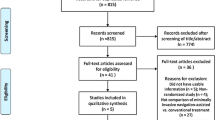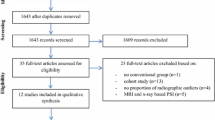Abstract
Purpose
The current study investigated the accuracy in achieving proper lower limb alignment and individual component positions after total knee arthroplasty (TKA) with 3 different instrumentation techniques. It was hypothesized that patient-specific instruments (PSI) would achieve more accurate lower limb alignment and component positions compared to conventional instruments (CON).
Methods
Ninety knees in 81 patients were randomized in 1:1:1 ratio into CON, computer navigation (NAV) and PSI groups to receive TKA. The surgical routines were standardized. The lower limb mechanical axis and individual component positions were assessed on standard radiographs. Tourniquet time, operation time and patients’ functional scores were documented.
Results
Conventional instruments and PSI were more likely to result in an excessively flexed femoral component (p = 0.001) compared to NAV. Number of outliers in postoperative lower limb alignment, and other components positions in the coronal and sagittal plane showed no statistically significant difference. The mean tourniquet time and operation time was significantly shorter in CON and PSI groups than NAV group (p < 0.001). Four early complications occurred in the PSI group (p = 0.015). At 3-month follow-up, there was no difference in terms of the knee range of motion and patients’ function among the 3 groups.
Conclusion
No significant radiological and clinical benefit could be demonstrated in using PSI over CON or NAV in TKA. Routine use of PSI is not recommended because of the extra cost and waiting time.
Level of evidence
I.


Similar content being viewed by others
References
Bargren JH, Blaha JD, Freeman MA (1983) Alignment in total knee arthroplasty. Correlated biomechanical and clinical observations. Clin Orthop Relat Res 173:178–183
Barrack RL, Ruh EL, Williams BM, Ford AD, Foreman K, Nunley RM (2012) Patient specific cutting blocks are currently of no proven value. J Bone Joint Surg Br 94(11 Suppl A):95–99
Bathis H, Perlick L, Tingart M, Luring C, Zurakowski D, Grifka J (2004) Alignment in total knee arthroplasty. A comparison of computer-assisted surgery with the conventional technique. J Bone Joint Surg Br 86(5):682–687
Begg C, Cho M, Eastwood S, Horton R, Moher D, Olkin I, Pitkin R, Rennie D, Schulz KF, Simel D, Stroup DF (1996) Improving the quality of reporting of randomized controlled trials: the CONSORT statement. JAMA 276(8):637–639
Bland JM, Altman DG (1986) Statistical methods for assessing agreement between two methods of clinical measurement. Lancet 1(8476):307–310
Blumenfeld TJ (2013) CORR Insights (R): Is TKA using patient-specific instruments comparable to conventional TKA? A randomized controlled study of one system. Clin Orthop Relat Res 471(12):3996–3997
Boonen B, Schotanus MG, Kerens B, van der Weegen W, van Drumpt RA, Kort NP (2013) Intra-operative results and radiological outcome of conventional and patient-specific surgery in total knee arthroplasty: a multicentre, randomised controlled trial. Knee Surg Sports Traumatol Arthrosc 21(10):2206–2212
Chauhan SK, Scott RG, Breidahl W, Beaver RJ (2004) Computer-assisted knee arthroplasty versus a conventional jig-based technique. A randomised, prospective trial. J Bone Joint Surg Br 86(3):372–377
Chen JY, Yeo SJ, Yew AK, Tay DK, Chia SL, Lo NN, Chin PL (2014) The radiological outcomes of patient-specific instrumentation versus conventional total knee arthroplasty. Knee Surg Sports Traumatol Arthrosc 22(3):630–635
Chiu KY, Yau WP, Ng TP, Tang WM (2008) The accuracy of extramedullary guides for tibial component placement in total knee arthroplasty. Int Orthop 32(4):467–471
Conteduca F, Iorio R, Mazza D, Caperna L, Bolle G, Argento G, Ferretti A (2013) Evaluation of the accuracy of a patient-specific instrumentation by navigation. Knee Surg Sports Traumatol Arthrosc 10:2194–2199
Cooke TD (2002) Definition of axial alignment of the lower extremity. J Bone Joint Surg 84-A(1):146–147
Cooke TD, Scudamore RA, Bryant JT, Sorbie C, Siu D, Fisher B (1991) A quantitative approach to radiography of the lower limb. Principles and applications. J Bone Joint Surg Br 73(5):715–720
Cooke TD, Sled EA, Scudamore RA (2007) Frontal plane knee alignment: a call for standardized measurement. J Rheumatol 34(9):1796–1801
Daniilidis K, Tibesku CO (2013) Frontal plane alignment after total knee arthroplasty using patient-specific instruments. Int Orthop 37(1):45–50
Ensini A, Timoncini A, Cenni F, Belvedere C, Fusai F, Leardini A, Giannini S (2014) Intra- and post-operative accuracy assessments of two different patient-specific instrumentation systems for total knee replacement. Knee Surg Sports Traumatol Arthrosc 22(3):621–629
Fang DM, Ritter MA, Davis KE (2009) Coronal alignment in total knee arthroplasty: just how important is it? J Arthroplasty 24(6 Suppl):39–43
Gothesen O, Espehaug B, Havelin LI, Petursson G, Hallan G, Strom E, Dyrhovden G, Furnes O (2014) Functional outcome and alignment in computer-assisted and conventionally operated total knee replacements: a multicentre parallel-group randomised controlled trial. Bone Joint J 96-B(5):609–618
Hvid I, Nielsen S (1984) Total condylar knee arthroplasty. Prosthetic component positioning and radiolucent lines. Acta Orthop Scand 55(2):160–165
Jeffery RS, Morris RW, Denham RA (1991) Coronal alignment after total knee replacement. J Bone Joint Surg Br 73(5):709–714
Jenny JY, Clemens U, Kohler S, Kiefer H, Konermann W, Miehlke RK (2005) Consistency of implantation of a total knee arthroplasty with a non-image-based navigation system: a case–control study of 235 cases compared with 235 conventionally implanted prostheses. J Arthroplasty 20(7):832–839
Kim YH, Kim JS, Choi Y, Kwon OR (2009) Computer-assisted surgical navigation does not improve the alignment and orientation of the components in total knee arthroplasty. J Bone Joint Surg Am 91(1):14–19
Kim YH, Kim JS, Yoon SH (2007) Alignment and orientation of the components in total knee replacement with and without navigation support: a prospective, randomised study. J Bone Joint Surg Br 89(4):471–476
Klatt BA, Goyal N, Austin MS, Hozack WJ (2008) Custom-fit total knee arthroplasty (OtisKnee) results in malalignment. J Arthroplasty 23(1):26–29
Krishnan SP, Dawood A, Richards R, Henckel J, Hart AJ (2012) A review of rapid prototyped surgical guides for patient-specific total knee replacement. J Bone Joint Surg Br 94(11):1457–1461
Lombardi AV Jr, Berend KR, Adams JB (2008) Patient-specific approach in total knee arthroplasty. Orthopedics 31(9):927–930
Lotke PA, Ecker ML (1977) Influence of positioning of prosthesis in total knee replacement. J Bone Joint Surg Am 59(1):77–79
Ng VY, DeClaire JH, Berend KR, Gulick BC, Lombardi AV Jr (2012) Improved accuracy of alignment with patient-specific positioning guides compared with manual instrumentation in TKA. Clin Orthop Relat Res 470(1):99–107
Nunley RM, Ellison BS, Ruh EL, Williams BM, Foreman K, Ford AD, Barrack RL (2012) Are patient-specific cutting blocks cost-effective for total knee arthroplasty? Clin Orthop Relat Res 470(3):889–894
Nunley RM, Ellison BS, Zhu J, Ruh EL, Howell SM, Barrack RL (2012) Do patient-specific guides improve coronal alignment in total knee arthroplasty? Clin Orthop Relat Res 470(3):895–902
Parratte S, Blanc G, Boussemart T, Ollivier M, Le Corroller T, Argenson JN (2013) Rotation in total knee arthroplasty: no difference between patient-specific and conventional instrumentation. Knee Surg Sports Traumatol Arthrosc 21(10):2213–2219
Ritter MA, Faris PM, Keating EM, Meding JB (1994) Postoperative alignment of total knee replacement. Its effect on survival. Clin Orthop Relat Res 299:153–156
Sparmann M, Wolke B, Czupalla H, Banzer D, Zink A (2003) Positioning of total knee arthroplasty with and without navigation support. A prospective, randomised study. J Bone Joint Surg Br 85(6):830–835
Tang WM, Chiu KY, Kwan MF, Ng TP, Yau WP (2005) Sagittal bowing of the distal femur in Chinese patients who require total knee arthroplasty. J Orthop Res 23(1):41–45
Thienpont E, Paternostre F, Pietsch M, Hafez M, Howell S (2013) Total knee arthroplasty with patient-specific instruments improves function and restores limb alignment in patients with extra-articular deformity. Knee 20(6):407–411
Yaffe M, Luo M, Goyal N, Chan P, Patel A, Cayo M, Stulberg SD (2013) Clinical, functional, and radiographic outcomes following total knee arthroplasty with patient-specific instrumentation, computer-assisted surgery, and manual instrumentation: a short-term follow-up study. Int J Comput Assist Radiol Surg. doi:10.1007/s11548-013-0968-6
Yau WP, Chiu KY, Tang WM (2007) How precise is the determination of rotational alignment of the femoral prosthesis in total knee arthroplasty: an in vivo study. J Arthroplasty 22(7):1042–1048
Yau WP, Chiu KY, Tang WM, Ng TP (2007) Coronal bowing of the femur and tibia in Chinese: its incidence and effects on total knee arthroplasty planning. J Orthop Surg (Hong Kong) 15(1):32–36
Yau WP, Chiu KY, Zuo JL, Tang WM, Ng TP (2008) Computer navigation did not improve alignment in a lower-volume total knee practice. Clin Orthop Relat Res 466(4):935–945
Author information
Authors and Affiliations
Corresponding author
Appendix: The inclusion and exclusion criteria
Appendix: The inclusion and exclusion criteria
The inclusion criteria included patients who were indicated for primary TKA, physically and mentally willing and able to comply with the postoperative scheduled clinical and radiographic evaluations, and agreed to sign an informed consent document specific to the study.
The exclusion criteria included patients who were not suitable for MRI or whose MRI failed to satisfy the manufacturer’s protocol; patients who had previous knee operations, extra-articular deformity in tibia or femur, associated medical diseases that could affect rehabilitation, active systemic infection or infection near the knee joint, current medical conditions that made them unfit for surgery or any conditions which in the opinion of the investigator suggested that the patient would not be compliant with the study protocol.
Rights and permissions
About this article
Cite this article
Yan, C.H., Chiu, K.Y., Ng, F.Y. et al. Comparison between patient-specific instruments and conventional instruments and computer navigation in total knee arthroplasty: a randomized controlled trial. Knee Surg Sports Traumatol Arthrosc 23, 3637–3645 (2015). https://doi.org/10.1007/s00167-014-3264-2
Received:
Accepted:
Published:
Issue Date:
DOI: https://doi.org/10.1007/s00167-014-3264-2




